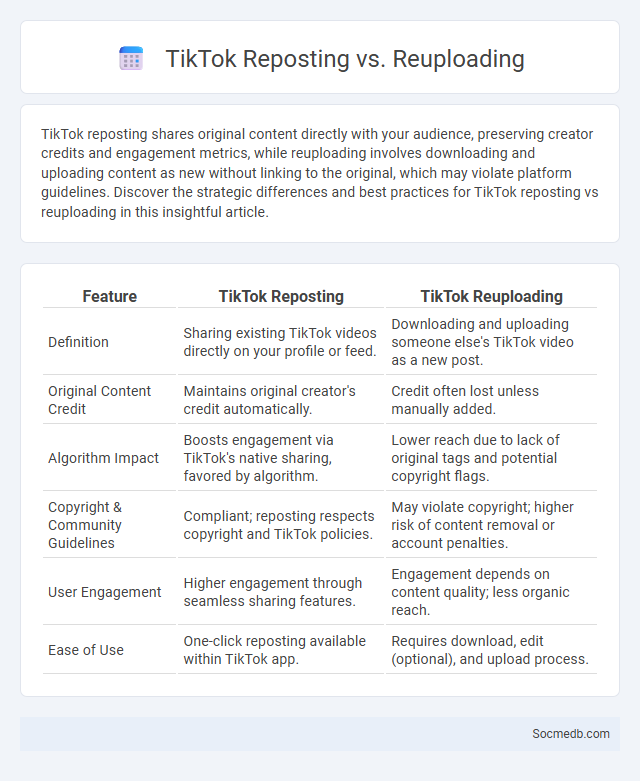
Photo illustration: TikTok Reposting vs Reuploading
TikTok reposting shares original content directly with your audience, preserving creator credits and engagement metrics, while reuploading involves downloading and uploading content as new without linking to the original, which may violate platform guidelines. Discover the strategic differences and best practices for TikTok reposting vs reuploading in this insightful article.
Table of Comparison
| Feature | TikTok Reposting | TikTok Reuploading |
|---|---|---|
| Definition | Sharing existing TikTok videos directly on your profile or feed. | Downloading and uploading someone else's TikTok video as a new post. |
| Original Content Credit | Maintains original creator's credit automatically. | Credit often lost unless manually added. |
| Algorithm Impact | Boosts engagement via TikTok's native sharing, favored by algorithm. | Lower reach due to lack of original tags and potential copyright flags. |
| Copyright & Community Guidelines | Compliant; reposting respects copyright and TikTok policies. | May violate copyright; higher risk of content removal or account penalties. |
| User Engagement | Higher engagement through seamless sharing features. | Engagement depends on content quality; less organic reach. |
| Ease of Use | One-click reposting available within TikTok app. | Requires download, edit (optional), and upload process. |
Understanding TikTok Content Sharing Methods
TikTok content sharing methods include direct sharing via in-app messages, sharing through external platforms like Instagram, Facebook, and WhatsApp, and downloading videos for offline viewing. You can also leverage TikTok's duet and stitch features to interact with and repost existing content, increasing engagement and visibility. Understanding these methods helps optimize content distribution and maximize reach on social media.
What Is TikTok Reposting?
TikTok reposting involves sharing existing videos from other users on your own TikTok profile without creating new content. This practice helps increase visibility and engagement by amplifying popular or relevant videos to a broader audience. Understanding TikTok reposting is crucial for content creators aiming to boost follower interaction and exploit trending topics effectively.
What Does Reuploading Mean on TikTok?
Reuploading on TikTok means posting a video again after it has already been shared on the platform, either by you or another user, often with slight modifications or updates. This practice can increase the reach and engagement of your content by targeting different audiences or capitalizing on trending topics. Understanding TikTok's community guidelines around reuploading helps ensure your content remains compliant and maximizes visibility.
Reposting vs Reuploading: Key Differences
Reposting preserves the original content's context, credits the creator, and shares it with your followers, enhancing engagement while respecting intellectual property. Reuploading involves downloading and publishing content as your own, potentially violating copyright and harming your credibility. Understanding this distinction helps you maintain ethical social media practices and build a trustworthy online presence.
TikTok’s Native Repost Feature Explained
TikTok's Native Repost feature allows you to share content seamlessly within the app, boosting the visibility of videos without the need for external sharing. This functionality enhances organic reach by promoting original creators while expanding your interaction with trending content. Utilizing the Native Repost tool, your engagement contributes directly to TikTok's algorithm, increasing the chances of content appearing on more For You pages.
Copyright Issues in Reposting vs Reuploading
Reposting content on social media typically involves sharing or embedding original posts with proper attribution, reducing copyright infringement risks compared to reuploading, which entails uploading content as a new post without creator permission. Copyright holders often enforce stricter policies against reuploading since it constitutes unauthorized reproduction and distribution, potentially leading to takedown notices or legal action. Understanding platform-specific guidelines and securing explicit consent are crucial to avoid copyright violations in digital content sharing.
User Engagement: Reposting vs Reuploading
User engagement on social media significantly increases when you choose reposting over reuploading, as reposting preserves original likes, comments, and shares that enhance credibility and reach. Reposting facilitates community interaction by maintaining authentic content context, which drives further engagement through user trust and content validation. Your strategy should prioritize reposting to amplify genuine social connections and optimize engagement metrics effectively.
Best Practices for Sharing TikTok Videos
To maximize engagement when sharing TikTok videos, ensure your content is authentic, visually appealing, and paired with trending hashtags relevant to your niche. Optimize video length for the platform's preference, typically between 15 to 60 seconds, to hold viewers' attention. You should also post consistently at peak times and interact with your audience through comments to boost visibility and growth.
Risks and Consequences of Reposting/Reuploading
Reposting or reuploading content on social media can lead to copyright infringement, resulting in account suspension or legal action against you. Sharing unverified information or sensitive material may damage your reputation and contribute to misinformation. Be aware that your digital footprint expands with every repost, potentially affecting your personal and professional life due to unintended exposure.
When to Repost vs When to Reupload on TikTok
Reposting on TikTok is ideal when you want to share popular or trending content without altering the original video, helping to maintain authenticity and capitalize on existing engagement. Reuploading is more effective when you aim to tweak or improve the content, such as editing for quality, updating captions, or targeting a new audience. Understanding TikTok's algorithm favors original content, so reuploading with unique elements can boost visibility, whereas reposting is best for quick sharing of already successful videos.
 socmedb.com
socmedb.com